Does Fire Influence the Greenness Index of Trees? Twelve Months to Decode the Answer in a Rarámuri Mixed Forest
Abstract
:1. Introduction
2. Materials and Methods
2.1. Study Area
2.2. Data Collection
2.3. Statistical Analysis
3. Results
4. Discussion
4.1. Intra-Annual Variation in NDVI Values at Individual Tree Crown Level
4.2. Variations in Tree NDVI values in Response to Fire Effects Are Contingent on the Tree Genus
4.3. The NDVI Responses to Fire Are Influenced by the Size of the Trees
4.4. Study Limitations
5. Conclusions
Author Contributions
Funding
Institutional Review Board Statement
Informed Consent Statement
Data Availability Statement
Acknowledgments
Conflicts of Interest
Appendix A
| Genus | Source of Variation | F | Pr (>F) |
|---|---|---|---|
| Arbutus | Date | 71.87 | <0.0001 |
| Burning treatment (B) | 6.443 | 0.0348 | |
| Total height (TH) | 0.738 | 0.4153 | |
| B × TH | 0.645 | 0.4450 | |
| Juniperus | Date | 8.454 | 0.0038 |
| Burning treatment (B) | 5.808 | 0.0199 | |
| Total height (TH) | 7.920 | 0.0071 | |
| B × TH | 5.220 | 0.0269 | |
| Quercus | Date | 388.20 | <0.0001 |
| Burning treatment (B) | 0.2097 | 0.6485 | |
| Total height (TH) | 14.958 | 0.0002 | |
| B × TH | 1.9575 | 0.1665 | |
| Pinus | Date | 187.93 | <0.0001 |
| Burning treatment (B) | 21.840 | <0.0001 | |
| Total height (TH) | 13.726 | 0.0002 | |
| B × TH | 6.1573 | 0.01351 |
References
- Forzieri, G.; Dakos, V.; McDowell, N.G.; Ramdane, A.; Cescatti, A. Emerging Signals of Declining Forest Resilience under Climate Change. Nature 2022, 608, 534–539. [Google Scholar] [CrossRef] [PubMed]
- Murray-Tortarolo, G.N. Seven Decades of Climate Change across Mexico. Atmósfera 2021, 34, 217–226. [Google Scholar] [CrossRef]
- Corona-Núñez, R.O.; Li, F.; Campo, J.E. Fires Represent an Important Source of Carbon Emissions in Mexico. Glob. Biogeochem. Cycles 2020, 34, e2020GB006815. [Google Scholar] [CrossRef]
- Montoya, L.E.; Corona-Núñez, R.O.; Campo, J.E. Fires and Their Key Drivers in Mexico. Int. J. Wildl. Fire 2023, 32, 651–664. [Google Scholar]
- Ma, J.; Zhang, C.; Li, S.; Yang, C.; Chen, C.; Yun, W. Changes in Vegetation Resistance and Resilience under Different Drought Disturbances Based on NDVI and SPEI Time Series Data in Jilin Province, China. Remote Sens. 2023, 15, 3280. [Google Scholar] [CrossRef]
- Fawcett, D.; Bennie, J.; Anderson, K. Monitoring Spring Phenology of Individual Tree Crowns Using Drone-Acquired NDVI Data. Remote Sens. Ecol. Conserv. 2021, 7, 227–244. [Google Scholar] [CrossRef]
- Lechner, A.M.; Foody, G.M.; Boyd, D.S. Applications in Remote Sensing to Forest Ecology and Management. One Earth 2020, 2, 405–412. [Google Scholar] [CrossRef]
- Talucci, A.C.; Forbath, E.; Kropp, H.; Alexander, H.D.; DeMarco, J.; Paulson, A.K.; Zimov, N.S.; Zimov, S.; Loranty, M.M. Evaluating Post-Fire Vegetation Recovery in Cajander Larch Forests in Northeastern Siberia Using UAV Derived Vegetation Indices. Remote Sens. 2020, 12, 2970. [Google Scholar] [CrossRef]
- Hossain, M.L.; Li, J. NDVI-Based Vegetation Dynamics and Its Resistance and Resilience to Different Intensities of Climatic Events. Glob. Ecol. Conserv. 2021, 30, e01768. [Google Scholar] [CrossRef]
- Acosta-Hernández, A.C.; Pompa-García, M.; Martínez-Rivas, J.A.; Vivar-Vivar, E.D. Cutting the Greenness Index into 12 Monthly Slices: How Intra-Annual NDVI Dynamics Help Decipher Drought Responses in Mixed Forest Tree Species. Remote Sens. 2024, 16, 389. [Google Scholar] [CrossRef]
- LaRochelle, S.; Berkes, F. Traditional Ecological Knowledge and Practice for Edible Wild Plants: Biodiversity Use by the Rarámuri, in the Sirerra Tarahumara, Mexico. Int. J. Sustain. Dev. World Ecol. 2003, 10, 361–375. [Google Scholar] [CrossRef]
- Fulé, P.Z.; Ramos-Gómez, M.; Cortés-Montaño, C.; Miller, A.M. Fire Regime in a Mexican Forest under Indigenous Resource Management. Ecol. Appl. 2011, 21, 764–775. [Google Scholar] [CrossRef] [PubMed]
- Azpeleta Tarancón, A.; Fulé, P.Z.; García Arévalo, A. Mexican Mixed-Species Forest Shows Resilience to High-Intensity Fire. Can. J. For. Res. 2023, 54, 500–511. [Google Scholar] [CrossRef]
- Pompa-García, M.; Sigala-Rodríguez, J.Á.; Vivar-Vivar, E.D.; Rodríguez-Flores, F.d.J.; Rascón-Solano, J. Diurnal Change of NDVI from UAV in Trees of a Temperate Unavenged Forest Stand. Rev. Mex. Cienc. For. 2024, 15, 50–68. [Google Scholar] [CrossRef]
- Caballero-Cruz, P.; Santiago-Juárez, W.; Martínez-Santiago, D.; Cruz-Santiago, O.L.; Pérez-Silva, E.R.; Aguirre-Calderón, O. Combustibles Forestales y Susceptibilidad a Incendios de Un Bosque Templado En La Mixteca Alta, Oaxaca, Mexico. For. Veracruzana 2018, 20, 9–14. [Google Scholar]
- Pan, N.; Wang, S.; Liu, Y.; Zhao, W.; Fu, B. Global Surface Soil Moisture Dynamics in 1979–2016 Observed from ESA CCI SM Dataset. Water 2019, 11, 883. [Google Scholar] [CrossRef]
- Bates, D.; Mächler, M.; Bolker, B.; Walker, S. Fitting Linear Mixed-Effects Models Using Lme4. J. Stat. Softw. 2015, 67, 1–48. [Google Scholar] [CrossRef]
- Lenth, R. Emmeans: Estimated Marginal Means, Aka Least-Squares Means, R Package Version 1.4.7; Available online: https://CRAN.R-project.org/package=emmeans (accessed on 15 March 2024).
- Wickham, H. Ggplot2: Elegant Graphics for Data Analysis; Springer: New York, NY, USA, 2016; ISBN 978-3-319-24277-4. [Google Scholar]
- Carvajal-Ramírez, F.; Marques da Silva, J.R.; Agüera-Vega, F.; Martínez-Carricondo, P.; Serrano, J.; Moral, F.J. Evaluation of Fire Severity Indices Based on Pre- and Post-Fire Multispectral Imagery Sensed from UAV. Remote Sens. 2019, 11, 993. [Google Scholar] [CrossRef]
- Pompa-García, M.; Martínez-Rivas, J.A.; Valdez-Cepeda, R.D.; Aguirre-Salado, C.A.; Rodríguez-Trejo, D.A.; Miranda-Aragón, L.; Rodríguez-Flores, F.D.; Vega-Nieva, D.J. NDVI Values Suggest Immediate Responses to Fire in an Uneven-Aged Mixed Forest Stand. Forests 2022, 13, 1901. [Google Scholar] [CrossRef]
- Craine, J.M.; Ocheltree, T.W.; Nippert, J.B.; Towne, E.G.; Skibbe, A.M.; Kembel, S.W.; Fargione, J.E. Global Diversity of Drought Tolerance and Grassland Climate-Change Resilience. Nat. Clim. Chang. 2013, 3, 63–67. [Google Scholar] [CrossRef]
- Zhang, Q.; Kong, D.; Singh, V.P.; Shi, P. Response of Vegetation to Different Time-Scales Drought across China: Spatiotemporal Patterns, Causes and Implications. Glob. Planet. Chang. 2017, 152, 1–11. [Google Scholar] [CrossRef]
- João, T.; João, G.; Bruno, M.; João, H. Indicator-Based Assessment of Post-Fire Recovery Dynamics Using Satellite NDVI Time-Series. Ecol. Indic. 2018, 89, 199–212. [Google Scholar] [CrossRef]
- Samiappan, S.; Hathcock, L.; Turnage, G.; McCraine, C.; Pitchford, J.; Moorhead, R. Remote Sensing of Wildfire Using a Small Unmanned Aerial System: Post-Fire Mapping, Vegetation Recovery and Damage Analysis in Grand Bay, Mississippi/Alabama, USA. Drones 2019, 3, 43. [Google Scholar] [CrossRef]
- Larrinaga, A.R.; Brotons, L. Greenness Indices from a Low-Cost UAV Imagery as Tools for Monitoring Post-Fire Forest Recovery. Drones 2019, 3, 6. [Google Scholar] [CrossRef]
- Pompa-García, M.; Camarero, J.J.; Rodríguez-Trejo, D.A.; Vega-Nieva, D.J. Drought and Spatiotemporal Variability of Forest Fires across Mexico. Chin. Geogr. Sci. 2018, 28, 25–37. [Google Scholar] [CrossRef]
- Wang, Q.; Adiku, S.; Tenhunen, J.; Granier, A. On the Relationship of NDVI with Leaf Area Index in a Deciduous Forest Site. Remote Sens. Environ. 2005, 94, 244–255. [Google Scholar] [CrossRef]
- Michaletz, S.T.; Johnson, E.A.; Tyree, M.T. Moving beyond the Cambium Necrosis Hypothesis of Post-Fire Tree Mortality: Cavitation and Deformation of Xylem in Forest Fires. New Phytol. 2012, 194, 254–263. [Google Scholar] [CrossRef]
- Bär, A.; Nardini, A.; Mayr, S. Post-Fire Effects in Xylem Hydraulics of Picea Abies, Pinus Sylvestris and Fagus Sylvatica. New Phytol. 2018, 217, 1484–1493. [Google Scholar] [CrossRef] [PubMed]
- Fernandes, P.M.; Vega, J.A.; Jiménez, E.; Rigolot, E. Fire Resistance of European Pines. For. Ecol. Manag. 2008, 256, 246–255. [Google Scholar] [CrossRef]
- Burrows, G.E.; Chisnall, L.K. Buds Buried in Bark: The Reason Why Quercus Suber (Cork Oak) Is an Excellent Post-Fire Epicormic Resprouter. Trees 2016, 30, 241–254. [Google Scholar] [CrossRef]
- Graves, S.J.; Rifai, S.W.; Putz, F.E. Outer Bark Thickness Decreases More with Height on Stems of Fire-Resistant than Fire-Sensitive Floridian Oaks (Quercus spp.; Fagaceae). Am. J. Bot. 2014, 101, 2183–2188. [Google Scholar] [CrossRef] [PubMed]
- Bravo, J.E.J.; Rodríguez-Trejo, D.A.; Myers, R.L. Fire Tolerance of Three Tree Species in Pine–Oak Forests of Chignahuapan, Puebla, Mexico. Int. J. Wildl. Fire 2012, 21, 873–881. [Google Scholar] [CrossRef]
- Rezaei, R.; Ghaffarian, S. Monitoring Forest Resilience Dynamics from Very High-Resolution Satellite Images in Case of Multi-Hazard Disaster. Remote Sens. 2021, 13, 4176. [Google Scholar] [CrossRef]
- Camarero, J.J.; Guijarro, M.; Calama, R.; Valeriano, C.; Pizarro, M.; Madrigal, J. Wildfires Improve Forest Growth Resilience to Drought. Fire 2023, 6, 161. [Google Scholar] [CrossRef]
- Rodríguez-Trejo, D.A.; Fulé, P.Z. Fire Ecology of Mexican Pines and a Fire Management Proposal. Int. J. Wildl. Fire 2003, 12, 23–37. [Google Scholar] [CrossRef]
- Isbell, F.; Craven, D.; Connolly, J.; Loreau, M.; Schmid, B.; Beierkuhnlein, C.; Bezemer, T.M.; Bonin, C.; Bruelheide, H.; de Luca, E.; et al. Biodiversity Increases the Resistance of Ecosystem Productivity to Climate Extremes. Nature 2015, 526, 574–577. [Google Scholar] [CrossRef] [PubMed]
- Valor, T.; González-Olabarria, J.R.; Piqué, M. Assessing the Impact of Prescribed Burning on the Growth of European Pines. For. Ecol. Manag. 2015, 343, 101–109. [Google Scholar] [CrossRef]
- Valor, T.; Battipaglia, G.; Piqué, M.; Altieri, S.; González-Olabarria, J.R.; Casals, P. The Effect of Prescribed Burning on the Drought Resilience of Pinus nigra ssp. salzmannii Dunal (Franco) and P. sylvestris, L. Ann. For. Sci. 2020, 77, 13. [Google Scholar] [CrossRef]
- Hislop, S.; Jones, S.; Soto-Berelov, M.; Skidmore, A.; Haywood, A.; Nguyen, T.H. Using Landsat Spectral Indices in Time-Series to Assess Wildfire Disturbance and Recovery. Remote Sens. 2018, 10, 460. [Google Scholar] [CrossRef]
- Fernández-Álvarez, M.; Armesto, J.; Picos, J. LiDAR-Based Wildfire Prevention in WUI: The Automatic Detection, Measurement and Evaluation of Forest Fuels. Forests 2019, 10, 148. [Google Scholar] [CrossRef]
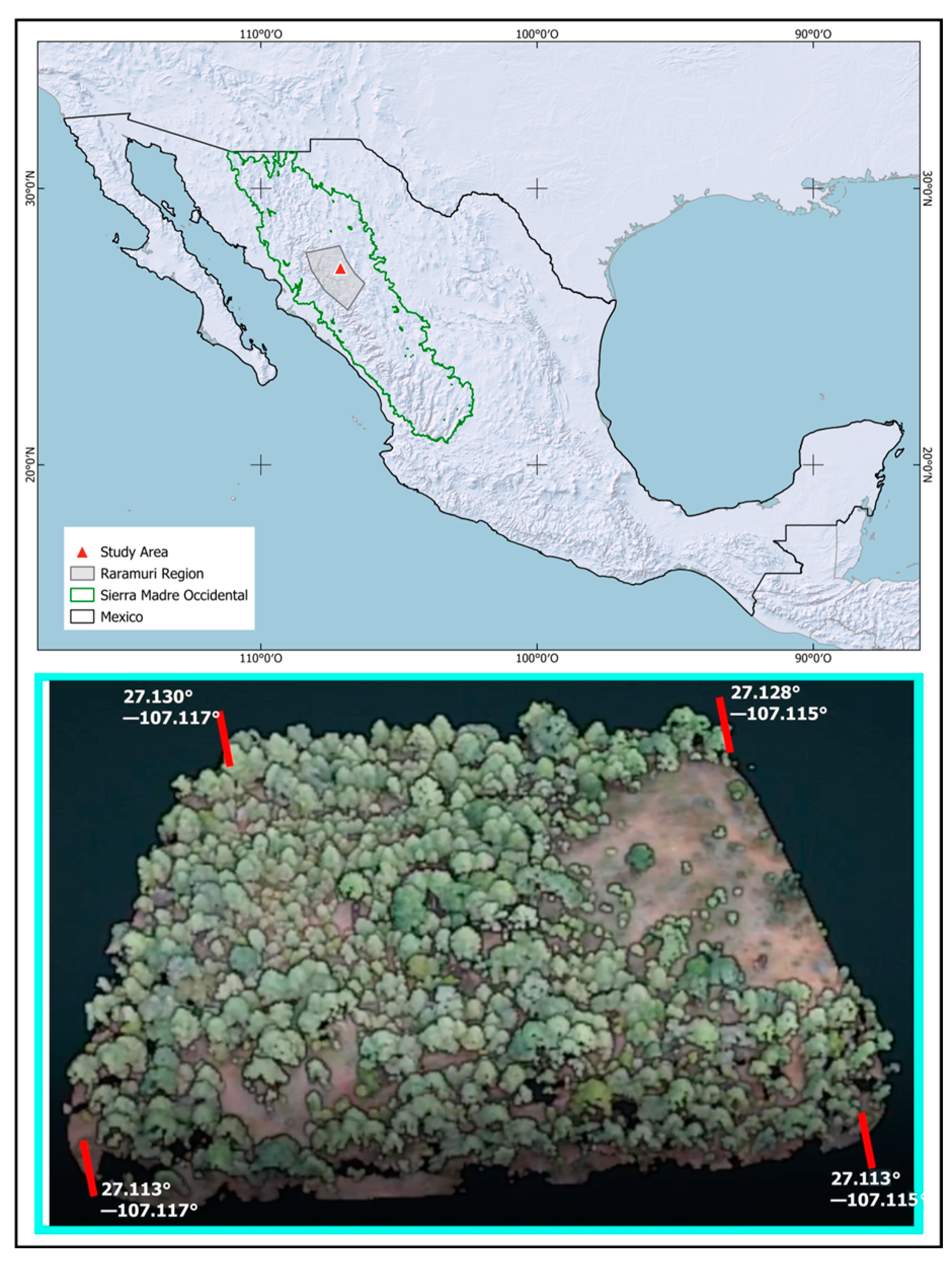
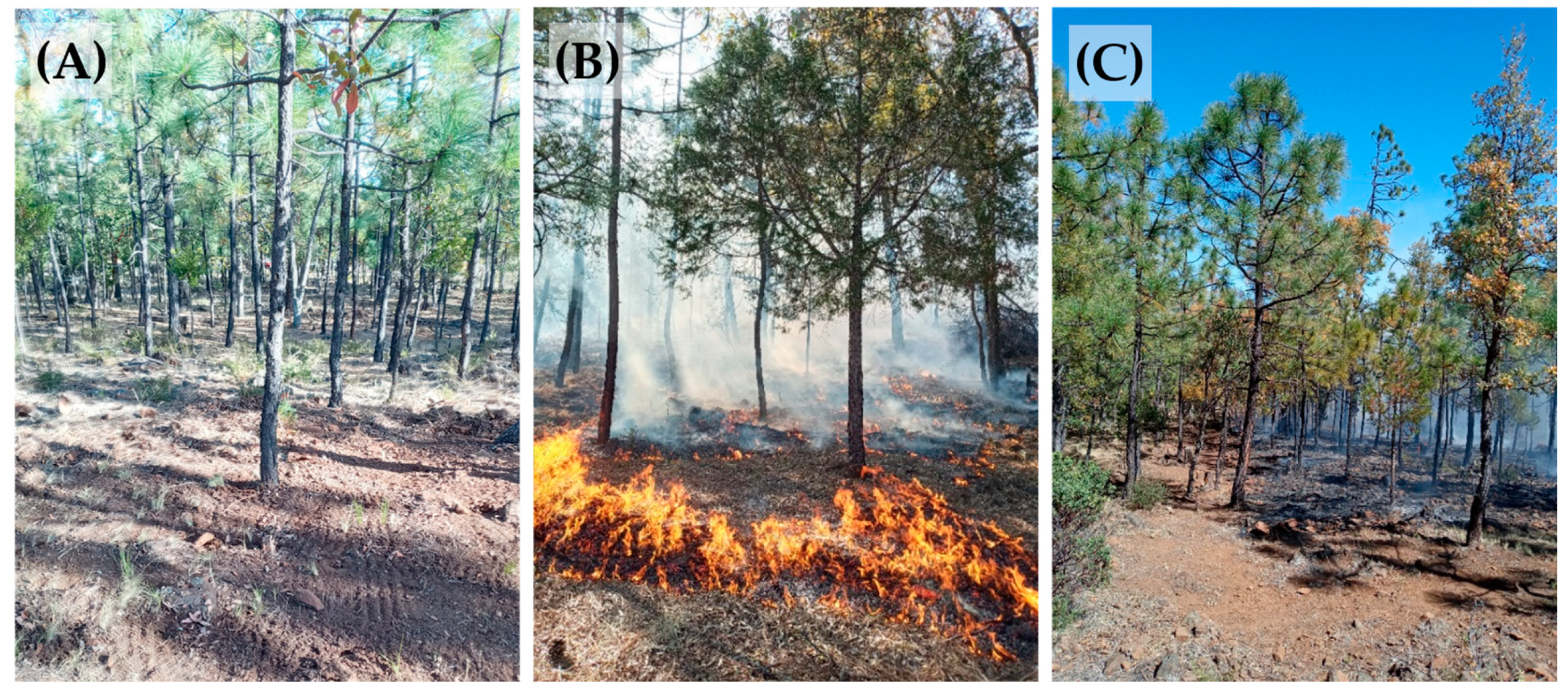
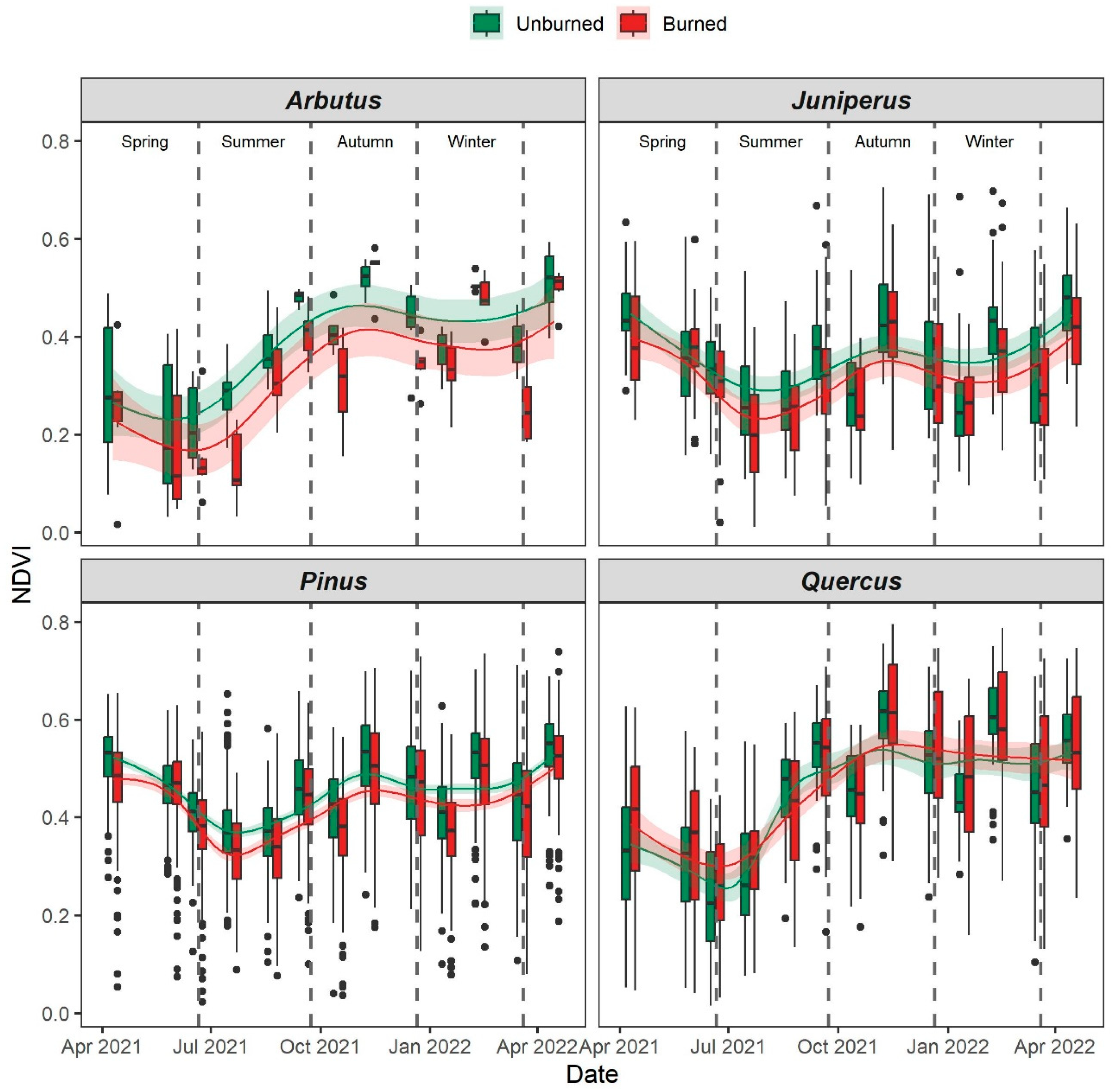
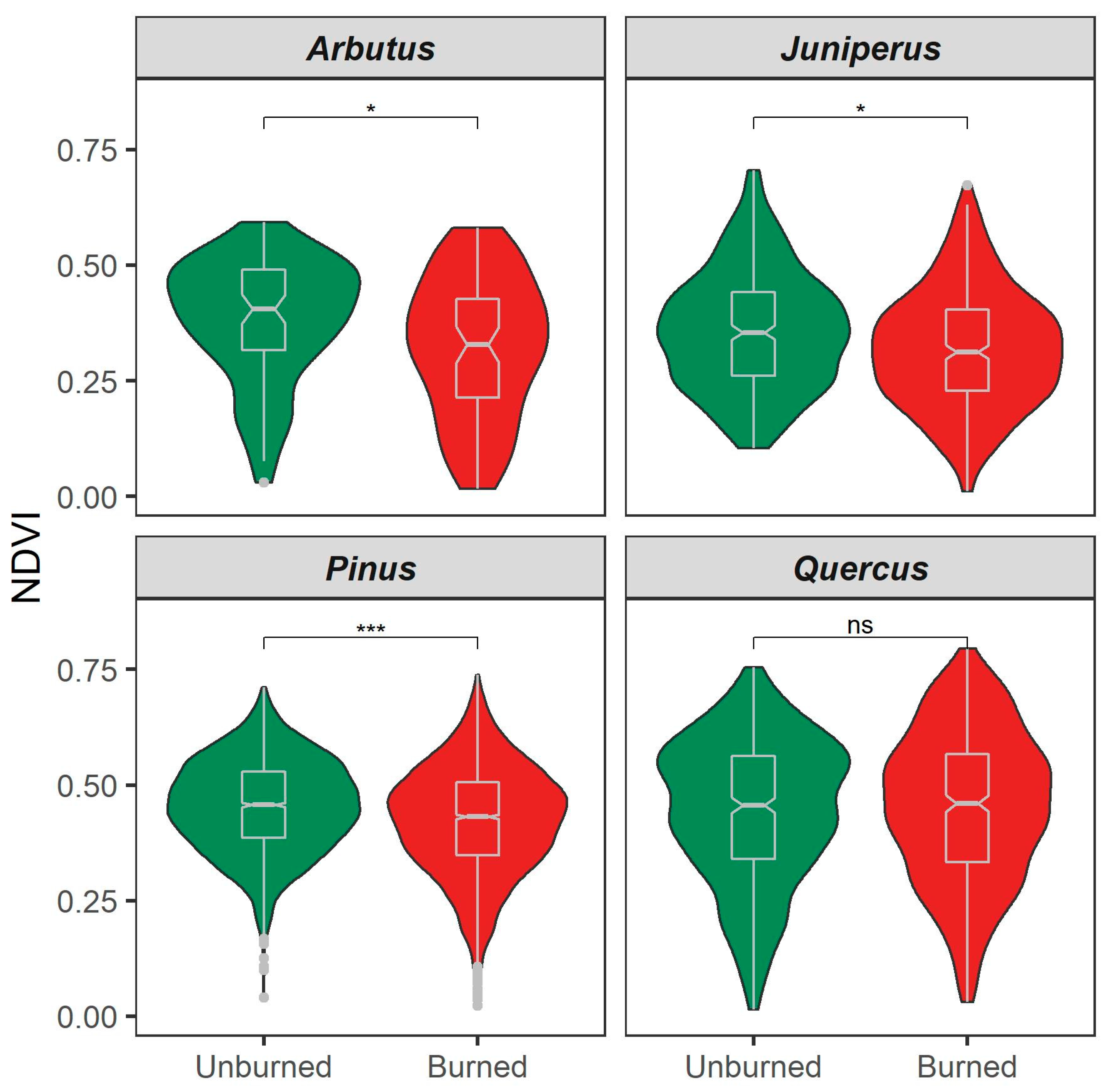
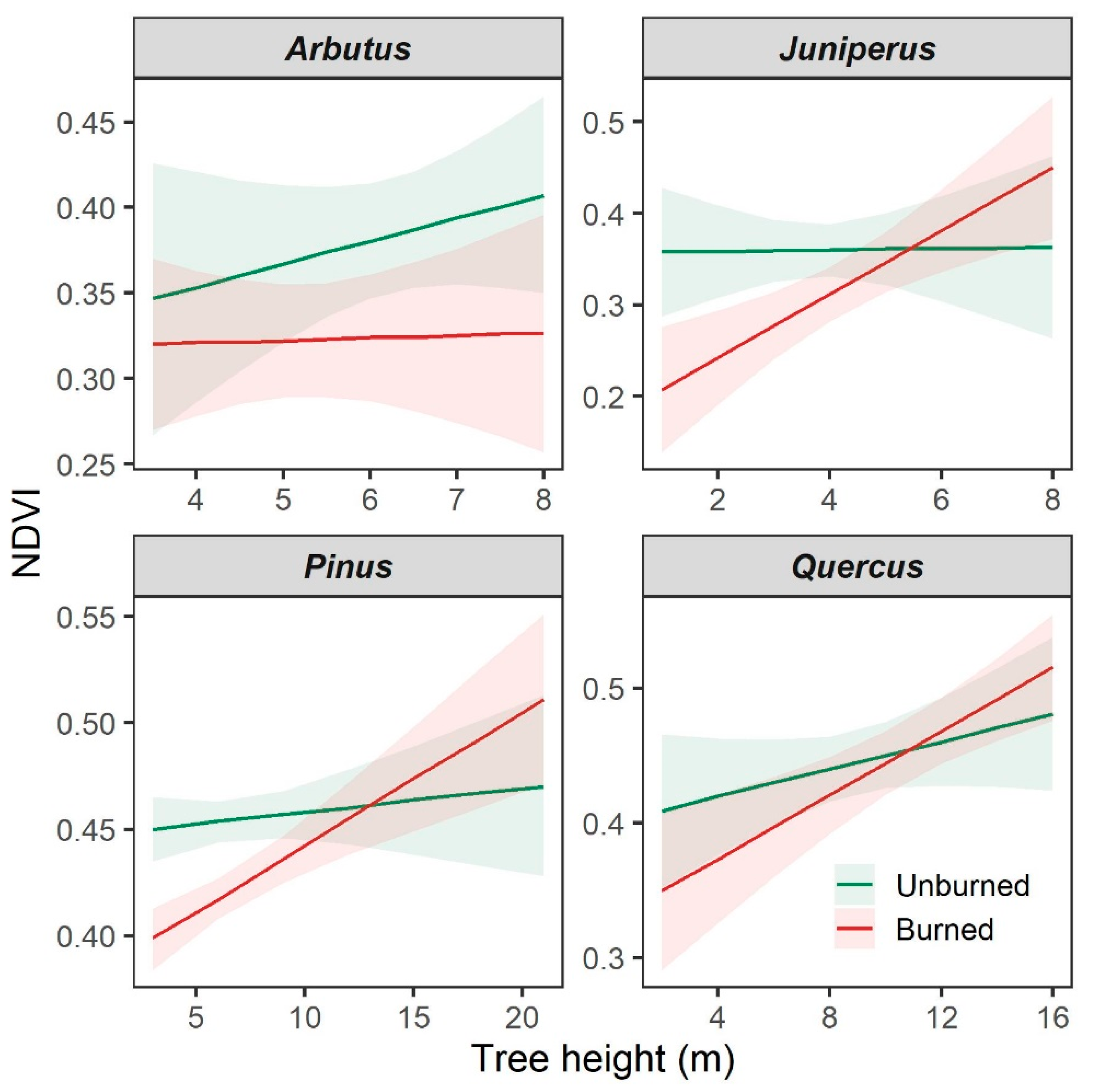
| Genus | Variable | n | Min | Max | Mean | Sd | Se | ||||||
|---|---|---|---|---|---|---|---|---|---|---|---|---|---|
| C | B | C | B | C | B | C | B | C | B | C | B | ||
| Arbutus | BD (cm) | 6 | 6 | 13 | 11 | 32 | 25 | 21 | 21 | 7 | 5 | 3 | 2 |
| DBH (cm) | 6 | 6 | 8 | 6 | 22 | 19 | 14 | 14 | 5 | 4 | 2 | 2 | |
| CH (m) | 6 | 6 | 1.60 | 0.70 | 3.00 | 2.10 | 2.03 | 1.41 | 0.52 | 0.45 | 0.21 | 0.18 | |
| TH (m) | 6 | 6 | 4.8 | 3.7 | 8.2 | 8.1 | 6.22 | 5.22 | 1.35 | 1.6 | 0.55 | 0.67 | |
| Juniperus | BD (cm) | 26 | 25 | 4 | 4 | 29 | 32 | 13 | 12 | 6 | 6 | 1 | 1 |
| DBH (cm) | 26 | 25 | 0 | 0 | 23 | 25 | 9 | 8 | 5 | 5 | 1 | 1 | |
| CH (m) | 26 | 25 | 0.90 | 0.40 | 2.40 | 3.40 | 1.80 | 1.97 | 0.40 | 0.59 | 0.10 | 0.20 | |
| TH (m) | 26 | 25 | 1.60 | 1.30 | 6.30 | 7.90 | 3.82 | 4.23 | 1.25 | 1.52 | 0.25 | 0.30 | |
| Pinus | BD (cm) | 195 | 194 | 7 | 7 | 64 | 66 | 16 | 15 | 8 | 9 | 1 | 1 |
| DBH (cm) | 195 | 194 | 5 | 5 | 52 | 56 | 12 | 11 | 7 | 7 | 1 | 1 | |
| CH (m) | 195 | 194 | 1.70 | 1.50 | 10.3 | 12.6 | 3.06 | 3.43 | 1.5 | 2.11 | 0.10 | 0.15 | |
| TH (m) | 195 | 194 | 2.90 | 0 | 21.4 | 20.8 | 6.94 | 6.94 | 3.17 | 3.38 | 0.23 | 0.24 | |
| Quercus | DBH (cm) | 35 | 35 | 7 | 7 | 58 | 60 | 32 | 35 | 16 | 16 | 3 | 3 |
| ND (cm) | 35 | 35 | 4 | 4 | 49 | 49 | 25 | 27 | 13 | 14 | 2 | 2 | |
| CH (m) | 35 | 35 | 0.4 | 0.6 | 5 | 9.20 | 2.35 | 3.05 | 1.12 | 1.80 | 0.19 | 0.30 | |
| TH (m) | 35 | 35 | 2.70 | 3.0 | 14.8 | 16.9 | 8.97 | 10.8 | 3.16 | 3.85 | 0.53 | 0.65 | |
Disclaimer/Publisher’s Note: The statements, opinions and data contained in all publications are solely those of the individual author(s) and contributor(s) and not of MDPI and/or the editor(s). MDPI and/or the editor(s) disclaim responsibility for any injury to people or property resulting from any ideas, methods, instructions or products referred to in the content. |
© 2024 by the authors. Licensee MDPI, Basel, Switzerland. This article is an open access article distributed under the terms and conditions of the Creative Commons Attribution (CC BY) license (https://creativecommons.org/licenses/by/4.0/).
Share and Cite
Pompa-García, M.; Rodríguez-Flores, F.d.J.; Sigala, J.A.; Rodríguez-Trejo, D.A. Does Fire Influence the Greenness Index of Trees? Twelve Months to Decode the Answer in a Rarámuri Mixed Forest. Fire 2024, 7, 282. https://doi.org/10.3390/fire7080282
Pompa-García M, Rodríguez-Flores FdJ, Sigala JA, Rodríguez-Trejo DA. Does Fire Influence the Greenness Index of Trees? Twelve Months to Decode the Answer in a Rarámuri Mixed Forest. Fire. 2024; 7(8):282. https://doi.org/10.3390/fire7080282
Chicago/Turabian StylePompa-García, Marín, Felipa de Jesús Rodríguez-Flores, José A. Sigala, and Dante Arturo Rodríguez-Trejo. 2024. "Does Fire Influence the Greenness Index of Trees? Twelve Months to Decode the Answer in a Rarámuri Mixed Forest" Fire 7, no. 8: 282. https://doi.org/10.3390/fire7080282







